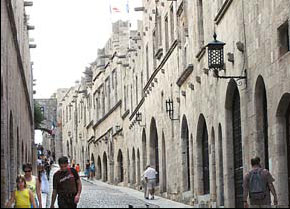Before our trip to Rhodes in Greece in October, I surfed the Internet and found an interesting link between the island and the Olympics. In the 5th century BC, Diagoras of Rhodes won in the 79th Olympiad in boxing. Decades later, his two sons, Damagetos and Akousilaos, also won in boxing and pancratium at the Olympiad.
The two young men crowned their father with their victory wreaths, held him on their shoulders and walked the victory lap.

Avenue of Knights in Rhodes.
A man in the crowd shouted: "Now it's time for you to die, Diagoras! Do not ask to go to the top of Olympus, too!" With the acclamations of the crowd, Diagoras died, proud and happy. But the story didn't end there. Dorieus, a younger son of Diagoras, later also became an Olympic champion, so did Eucles and Peisidoros, grandsons of Diagoras.
Kallipateira, a daughter of Diagoras, is said to be the only woman who violated a ban on women in the Olympic stadium. However, she was not condemned for this action. When the judges asked her how she dared to enter the stadium, she replied proudly that her father, brothers and son were Olympic champions, so she deserved that.
But when we finally landed at Rhodes in the southeastern corner of Greece, the barren fields looked disappointing. Even the famed olive trees appeared beaten by the scorching sun. Yet during the three days of our stay, we made many discoveries.
Located at the crossroads of Europe, Asia and Africa, Rhodes has attracted various people throughout history. Every race that arrived in Rhodes, peacefully or after winning a war, has left a trace on the beautiful island.
Like many first time visitors, I began to understand the diversity of Rhodes at the imposing fortress left by the Knights of St John. Originally a religious order of the church of Rome, the knights helped pilgrims travel to Jerusalem in the 11th century.
After they were expelled from the Holy Land, the knights stayed in Rhodes between 1309 and 1522, turning the island into a mighty bulwark at the easternmost point of the Christian West against the Muslims of the East.
According to their places of origin, the knights were divided into seven "tongues" - England, France, Germany, Italy, Aragon, Auvergne and Provence. Later Spain was added, so each of the eight groups stayed at its own lavishly decorated inn along the Avenue of the Knights.
As I scaled the steep cobbled avenue in the heart of the old town, I heard a myriad of tongues from the hordes of visitors. There are many crocodile-shaped stone sculptures atop the buildings that direct rain off the roof. To my untrained eye, they looked like the twins with the dragons in the Forbidden City of Beijing.
The grand masters of the knights, who were chosen for life, lived in the Palace of the Grand Masters overlooking the old town. Though it was destroyed in a gunpowder explosion of 1856, the Italians rebuilt it in a grandiose manner, intending it as a holiday home for Benito Mussolini and King Emmanuel III. It is now a museum, containing sculptures, mosaics and antique furniture.
While Rhodes lies at the northern tip of the island, Lindos is about half an hour's ride away on the southeastern coast. Much smaller in size, the town has a longer history. In 1100 BC, the Dorians founded the three cities of Lindos, Kameiros and Ialyssos, which jointly established Rhodes in 408 BC.
The first destination of most tourists to Lindos is the Doric Temple of Athena Lindia. Kleoboulos, one of the seven sages of the ancient world, rebuilt a temple of Athena in the 6th century BC on the site of an earlier structure on a hill facing the sea.

The Athena Temple at Lindos was built in the 6th century BC. Photos by Liu Jun
Though not as magnificent in scale as the Acropolis in Athens, the ruined architecture on Lindos struck me with an air of weighty history, against the azure Aegean Sea.
At the foot of the acropolis, I caught sight of a huge outline on the cliff. It is of a Rhodian ship carved by famed sculptor Pythokritos in the 2nd century BC. It made me wonder about the mysterious early history of the island.
Like other islands of Greece, Rhodes has a history interwoven with mythology, an everlasting source of inspiration for the souvenir industry. A popular theme for the local ceramic plates is the deer, which bears proof of the island's proudest memory.
In 305 BC, the Macedonian general Demetrius Poliorkitis (the "Besieger of Cities") tried to conquer Rhodes but failed after a long siege.
To thank their guardian Helios (Sun), the Rhodian people spent more than 12 years building a 32-m bronze statue of Helios Apollo (Colossus of Rhodes). Considered one of the Seven Wonders of the Ancient World, the statue was thought to have straddled Mandraki harbor, though this is now refuted.
The statue only stood for 65 years before collapsing in an earthquake. Today, a bronze doe and stag standing on two stone pillars at the Mandraki harbor mark the supposed site of the ancient wonder.
As I roamed the shops, bars and restaurants, I found the locals were very friendly with a few Chinese faces. At a store selling globes made with colored glaze, the owner said he got the products from China. Another lady selling blue glazed fish said she dreamed of visiting Beijing during the Olympics.
Though I didn't find traces of Diagoras, the ancient Olympic champion from Rhodes, I did feel a link between the hospitable island and my motherland.
(China Daily February 28, 2008)